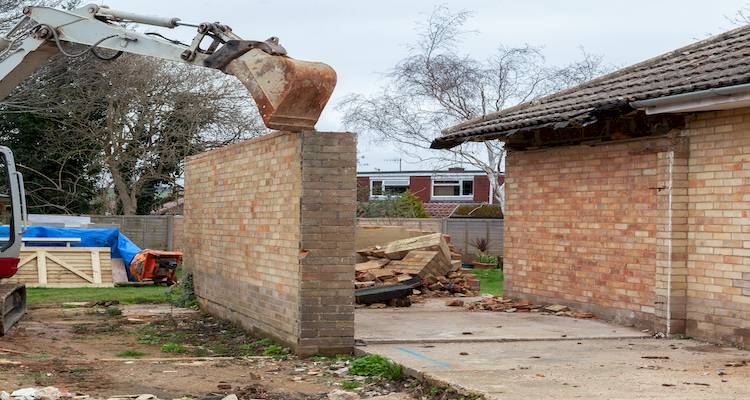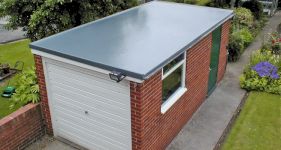Ceiling Panelling Cost
- The average cost of ceiling panelling is £150 per m².
- It usually takes around 1 to 2 days to fit a panelled ceiling.
- A complete ceiling panelling cost breakdown, including prices for budget, mid-range, and high-end ceiling panelling, as well as the cost of wood ceiling panels.
- How long it takes to install ceiling panels, and an idea of jobs you can do at the same time.
- How to find ceiling panel fitters near you.
Wondering how much ceiling panelling costs?
Typically, the cost of ceiling panelling is around £150 per m². Oak ceiling panelling has higher costs of £300 to £400 per m² due to the quality of the material.
In this guide, we will go over everything you need to know about ceiling panelling, including the supply costs, labour costs, and any additional costs involved with this type of work.
We will also look at what's involved with installing ceiling panelling, the different types of ceiling panelling, and some tips on finding the right contractors to install ceiling panelling for you.
Ready for a ceiling panelling installation quote?
MyJobQuote can connect you with thousands of ceiling panel fitters near you, ready to give you free, no obligation quotes.
Prefer to learn more about ceiling prices first? Keep reading!
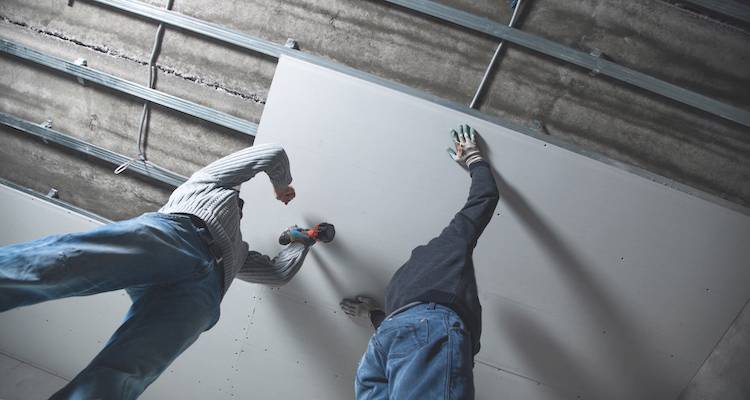
£150 per m²
Table of Contents
- How Much Does Installing Ceiling Panelling Cost?
- Supply Only Costs
- Additional Costs
- Labour Costs and Timescales
- Cost Factors of Installing Ceiling Panelling
- What's Involved in Installing Ceiling Panelling?
- Can I Install Ceiling Panelling Myself?
- Types of Ceiling Panelling
- Hiring Contractors for Installing Ceiling Panelling Checklist
- FAQs
How Much Does Installing Ceiling Panelling Cost?
So, how much does a panelled ceiling cost?
Ceiling panelling can range in price depending on the quality of the finish. Budget ceiling panelling can be purchased cheaply at around £12 to £50 per m², while mid-range ceiling panels cost around £30 to £100 per m².
At the other end of the scale, high-quality ceiling panels cost around £100 to £300 per m².
The total cost of a ceiling panel installation will depend on the total area being covered. The larger your ceiling, the more you can expect to pay in material costs. Larger areas will also take longer to complete, so the labour costs will be higher for larger jobs.
The price will also be affected by the quality of the materials and your location in the UK.
I have a lathe and plaster ceiling that has been wallpapered and painted over, the paper is peeling and it looks awful. I don’t know if it’s even worth attempting to get the paper off or if the ceiling will need to come down, regardless. Roughly how much would you charge to remove it and replace it?
Ceiling Panelling Prices
The table below shows the average cost of installing various types of ceiling panelling:
| JOB DESCRIPTION | AVERAGE COST PER m² |
|---|---|
| Budget ceiling panelling | £12 - £50 |
| Mid-range ceiling panelling | £30 - £100 |
| High-end ceiling panelling | £100 - £300 |
| Oak ceiling panelling | £300 - £400 |
| Pine ceiling panelling | £15 - £30 |
| Bespoke ceiling panelling | £100 - £300 |
Supply Only Costs
The installation of ceiling panels can be done in many ways. They are usually either screwed or stapled into place. You may also choose to use an adhesive to fit the ceiling panels in place. Many ceiling panel fitters use both adhesive and staples to fit the boards.
If you plan on installing the ceiling boards, you may be interested in learning how much the materials cost. In this section, we will go over the prices for materials for this type of job.
Ceiling panels may be installed directly onto plaster, artexed, or lath and plaster ceiling, as long as it is in good condition and is even.
If the room is a new addition or if it has been newly constructed, the cladding can be added over the plasterboard, which prevents the need to plaster. Plasterboard installation will cost around £7 to £20 per m².
The average cost of the ceiling panels themselves is around £30 to £50 per m². You will also need staples, which cost around £5 to £20.
A tape measure costs around £2 to £6, adhesive costs around £1 to £5, and plasterboard fixings cost around £4 to £8.
Depending on how you’re fixing the ceiling boards, you may need some additional items. Below is a table showing the average cost for various supplies for this type of work:
| TYPE OF SUPPLIES | AVERAGE COST |
|---|---|
| Plasterboard | £7 - £20 |
| Ceiling panels | £30 - £50 |
| Staples | £4 - £11 |
| Tape measure | £5 - £20 |
| Adhesive | £1 - £5 |
| Plasterboard fixings | £4 - £8 |
| Joists | £12 - £20 |
| Ceiling battens | £10 - £15 |
Additional Costs
You may need to consider several additional costs when installing ceiling panelling. Below is a list of the additional things that you may need to budget for with this type of work:
Plastering
If the room's walls and ceiling look a bit old, tired, and uneven, you may need to plaster the room before adding any additional décor. The cost to plaster a room will depend on the size of the room.
However, you can expect to pay anywhere from £400 to £1,500 for this type of work.
Decorating a Room
If you are installing ceiling panelling as a way of improving the overall look of the room, then you may want to consider also decorating your room in more ways - and this could include painting the room. The average cost of painting a room is around £300 to £500.
The price will depend on the room's size and the paint's quality.
You can also opt for wallpapering if you want to achieve a different look. Wallpapering costs £300, with higher prices associated with large rooms and more premium-quality wallpaper.
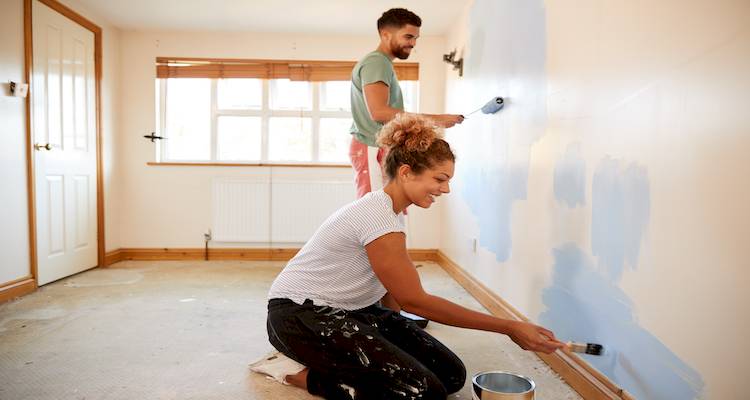
Installing Coving
To give your room a neat finish, you can add in coving to create a seamless join between your walls and ceiling. Coving costs £340 on average, with bespoke coving costing between £400 to £800 in supply costs only.
Painting Skirting Boards
Moving down the walls, skirting board painting costs £200, and can rejuvenate tired boards with cracked or peeling old paint.
New Light Fittings
Once your interior cladding panels have been installed, you may then be interested in adding a new light fitting. Light fittings can vary in cost, depending on the style and quality of the light fitting you choose.
The average cost of installing new light fittings in a room is around £80 to £200.
Labour Costs and Timescales
If you are planning on buying the materials for the job separately and then hiring a contractor at a later date, then you may be interested in learning about the price that you can expect to pay for the labour side of the job alone. You may also be curious to learn about the timescales that you can expect with this type of work.
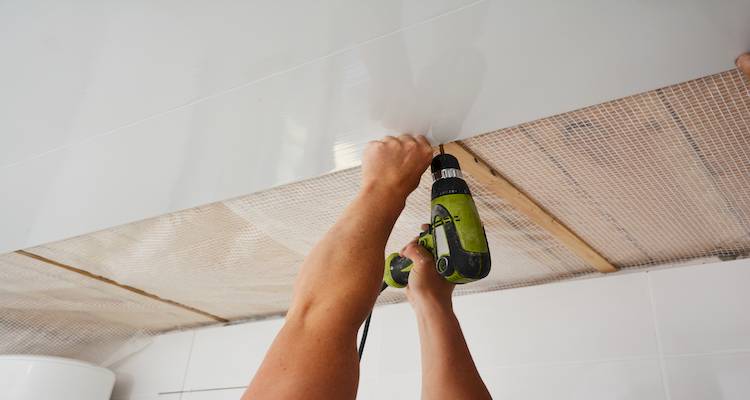
You can expect a plasterer to charge around £150 to £200 per day, and a labourer will charge around £80 to £100 per day. In most cases, if the job is quite straightforward and no issues arise, your ceiling panelling installation will take no more than a day to complete.
You may be able to save yourself some money on the labour costs by completing part of the work yourself. If your old ceiling needs to be removed, you could do this yourself to avoid paying additional labour fees for this part of the work.
Cost Factors of Installing Ceiling Panelling
Several things may affect the overall cost of installing ceiling panelling. Below is a list of the things that may affect the cost of this job:
Type of Ceiling Panelling
As we have mentioned earlier, there are many different types of ceiling panels, and they all come at varying costs. If you choose budget ceiling panels, the overall cost of the job will be much cheaper. However, if you choose bespoke, high-end ceiling panels, you can expect the overall cost of the job to be quite a bit more.
Location of Property
The location of your property will affect the overall cost of installing ceiling panelling. Those in the London area can expect to pay more for the labour side of the job than those in the north or different parts of the UK. This is because the labour costs in this area tend to be higher across the board than in other parts of the UK.

Number of Tradespeople
The number of tradespeople working on the job will also affect the cost. More people may be required depending on the size and type of panels that you choose. The more tradespeople needed for the job, the higher the overall price is likely for the work.
What's Involved in Installing Ceiling Panelling?
Depending on the type of ceiling panels that are being installed, the method for installing them may vary. However, most of the elements will be the same. Below is a step-by-step guide on installing ceiling PVC panels with start-finish trim.
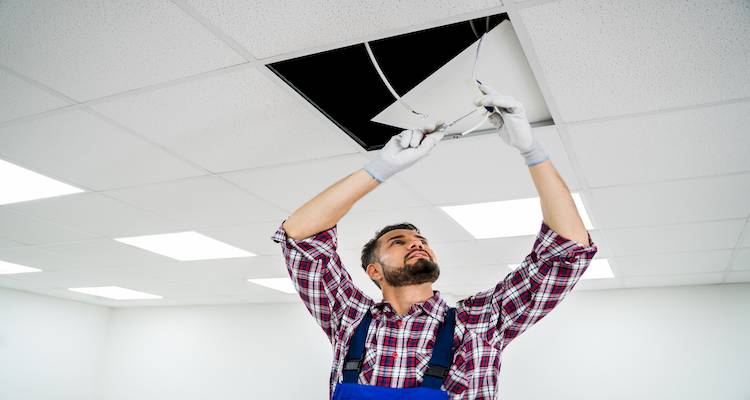
If you are installing ceiling panels yourself, you should always refer to the manufacturer's instructions, as the installation methods can vary from brand to brand.
- Measure the ceiling and then cut the back section of the two-part start-finish trim to length
- Fix this back section to the perimeter of the ceiling with screws at a spacing of approximately 300mm apart
- Measure the ceiling length as accurately as you can and transfer these measurements onto the panels with a pencil before cutting them to size
- Cut the ceiling panels with a hand saw or table saw
- Once the panels have been cut, apply a good amount of adhesive to the back and secure it in place on the ceiling with some screws at around 300mm intervals along the tongue section of the panel
- Repeat this process for every panel, locking each of them into place with the next using the tongue and groove edges
- Re-measure the perimeter and then cut and mitre the outer part of the start-finish trim
- Click this trim firmly into place
- Your ceiling board installation is now complete. You may add an optional layer of white silicone around the edges of the trim to remove any small gaps between the trim if your walls are uneven
Can I Install Ceiling Panelling Myself?
In some cases, you may be able to install ceiling panelling yourself as a DIY project, and, in other cases, you won’t be able to.
Lighter ceiling panelling options are relatively easy to install – especially if you choose tongue and groove clicking panelling. However, many ceiling panelling options are made from heavier materials such as wood. This makes the job much more difficult and requires more than one person to complete.
In most cases, people prefer to leave this type of work up to the professionals. This ensures that the job is done correctly and that every aspect of the installation is safe, meaning you won't have to worry.
Types of Ceiling Panelling
There are several different types of ceiling panelling to choose from. Below, we take a look at some of the most common ceiling panelling materials and the pros and cons of each type:
Polystyrene Ceiling Panelling
Polystyrene ceiling panels are the most common type of material for this type of work. They are available in a range of styles and thicknesses and tend to be lightweight and inexpensive. You can choose different effects such as moulded, smooth, plaster, woven, or more.
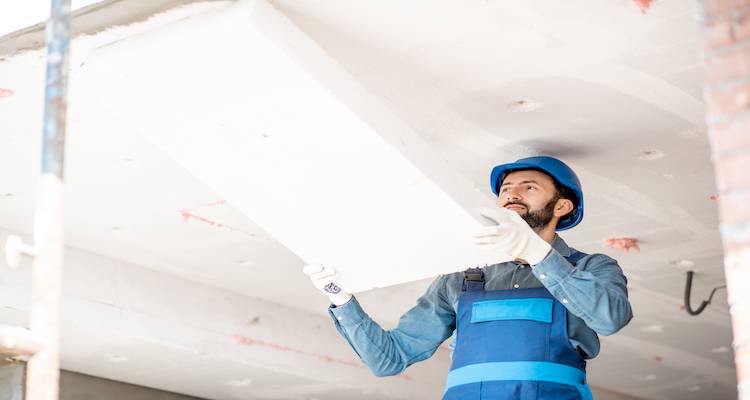
White is usually the most common option. However, you can also find various other colours, including faux wood effects. Alternatively, these ceiling panels can be painted in a colour of your choice.
PROS
- ✔ Low in cost
- ✔ Lightweight
- ✔ Easy to install
- ✔ Various styles to choose from
- ✔ Can be painted
CONS
- ✖ Not as attractive as some other materials
- ✖ They are flammable
PVC Ceiling Panelling
PVC is a material with many benefits. It can be used to create beautiful ceiling panels that are lightweight, resistant to moisture, rot-proof, and resistant to mould and fungi. With this in mind, PVC ceiling panels are great for kitchens and bathrooms. This material is also easy to maintain and comes in a range of colours and styles.
PROS
- ✔ Lightweight
- ✔ Water-resistant
- ✔ Rot-proof
- ✔ Resistant to mould and fungi
- ✔ Great for kitchens and bathrooms
- ✔ Easy to maintain
- ✔ Comes in a range of colours and styles
CONS
- ✖ Can warp over time
- ✖ Not the most attractive option
Plaster Ceiling Panelling
These ceiling panels are mostly chosen due to their aesthetic and can be made from either plaster or plasterboard. They are easy to install, lightweight, and can be cut very easily using just a knife and a straight edge.
Depending on the brand, some plaster ceiling tiles are moisture-resistant and can provide soundproofing qualities.
PROS
- ✔ Can provide soundproofing qualities
- ✔ Easy to install
- ✔ Lightweight
- ✔ Some brands are water-resistant
CONS
- ✖ They can be quite flimsy
Wood Ceiling Panelling
Wood ceiling panels are known for their style and charm. Most models are made from chipboard or MDF with a wood veneer. These panels come in a range of colours and can be made to look like all different types of wood species.
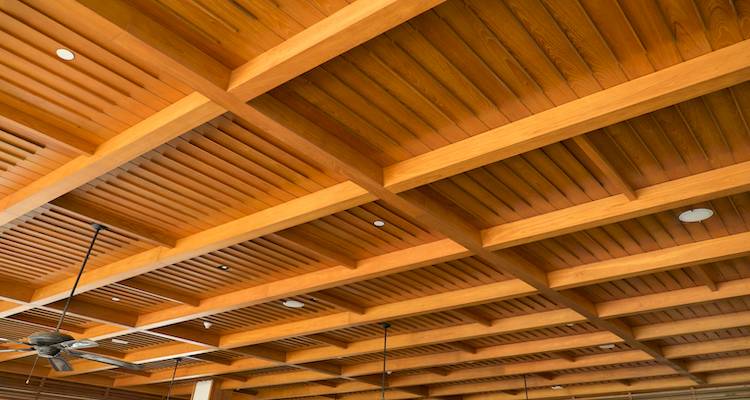
They also come in a range of finishes, including matt, natural, or sating. These panels can be treated to resist water and come in various classes regarding their resistance to fire.
PROS
- ✔ Charming and stylish
- ✔ Come in a range of colours and styles
- ✔ A range of finishes to choose from
- ✔ They can be treated to resist water
CONS
- ✖ They are mostly not very resistant to fire
- ✖ They are not resistant to water unless treated
- ✖ They are more difficult to install
Hiring Contractors for Installing Ceiling Panelling Checklist
There are many things you may need to consider before hiring a contractor to install ceiling panelling for you. Below is a list of some of the main things that you should consider when finding the right contractor for the job:
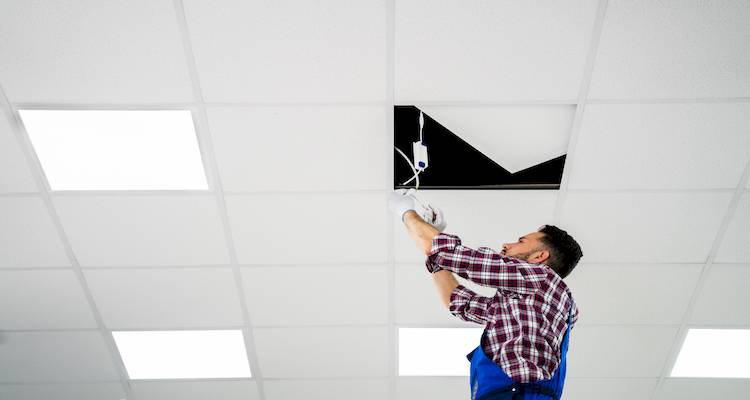
- Does the contractor provide any guarantees with the work, and what is included in the guarantee?
- How much does the work cost to complete? – Ask for a breakdown of the costs so that you can ensure you are paying a good price for each part of the job.
- Is the contractor experienced in installing the type of ceiling panels that you require?
- How much experience does the contractor have in installing ceiling panelling?
- Will the contractor fix any issues that may arise?
- Do you need to hire any additional contractors for different parts of the job, or do you need to provide anything for the work?
- How long will the work take to complete?
- Can the contractor provide any photographs of previous work?
- Will the contractor take care of any relevant waste removal as part of the job?
FAQs
How to panel a ceiling with tongue and groove panelling?
Nail the tongue to the nailing surface. Continue this process on all rows. The tongue and groove system should easily slide and lock into place, creating a flush appearance all over.



